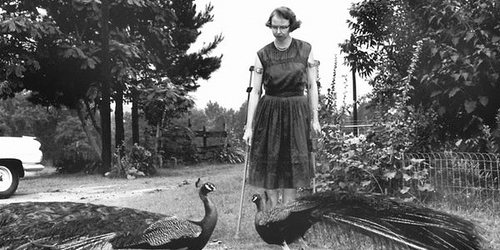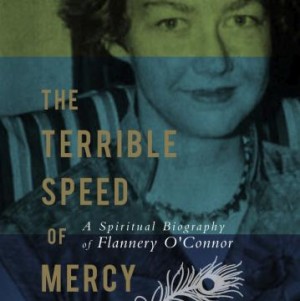
Novelist and O’Connor scholar Jonathan Rogers writes:
Readers are often offended by Flannery O’Connor’s stories.
They ought to be; the stories are offensive.
Jesus’s parables would offend us, too, if we hadn’t heard them so many times—or if we were paying better attention.
In the Parable of the Prodigal Son, we can all understand why the older brother, the one who has kept his nose clean, is offended by his father’s eager welcoming of the wayward brother. It’s a little shocking to realize that Jesus presents the older brother as just as big a jerk as the younger brother. Consider how much more shocking it would have been for Jesus’s original audience, who hadn’t already been told what they were supposed to think about the story.
The parables are driven by that dissonance between the truth and the way we feel about the truth. Jesus shows us what the kingdom of God looks like; if we allow ourselves to be offended by that vision, we begin to see what needs to happen in our hearts.
I say I love grace, but I’m bothered by the fact that the vineyard workers who showed up an hour before dark get paid the same amount as the workers who started at daybreak. I can either reject that parable altogether, or I can think about why my heart doesn’t line up with the things I say I believe. But it would be a big mistake to explain away the offense—to say it’s not really that offensive.
O’Connor was working from Jesus’s playbook. She used shock and offense to show us something about our hearts. “To the hard of hearing you shout,” she wrote, “and for the almost blind you draw large and startling figures.”
Rogers explores these ideas in the introduction to his book, The Terrible Speed of Mercy:
If [O’Connor’s] stories offend conventional morality, it is because the gospel itself is an offense to conventional morality. Grace is a scandal; it always has been. Jesus put out the glad hand to lepers and cripples and prostitutes and losers of every stripe even as he called the self-righteous a brood of vipers.
In “A Good Man Is Hard to Find,” it is painful to see a mostly harmless old grandmother come to terms with God and herself only at gunpoint.
It is even more painful to see her get shot anyway.
In a more properly moral story, she would be rewarded for her late-breaking insight and her life would be spared. But the story only enacts what Christians say they believe already: that to lose one’s body for the sake of one’s soul is a good trade indeed. It’s a mystery, and no small part of the mystery is the reader’s visceral reaction to truths he claims to believe already. O’Connor invites us to step into such mysteries, but she never resolves them. She never reduces them to something manageable.
O’Connor speaks with the ardor of an Old Testament prophet in her stories. She’s like an Isaiah who never quite gets around to “Comfort ye my people.” Except for this: there is a kind of comfort in finally facing the truth about oneself. That’s what happens in every one of Flannery O’Connor’s stories: in a moment of extremity, a character—usually a self-satisfied, self-sufficient character—finally comes to see the truth of his situation. He is accountable to a great God who is the source of all. He inhabits mysteries that are too great for him. And for the first time there is hope, even if he doesn’t understand it yet . . .
In O’Connor’s unique vision, the physical world, even at its seediest and ugliest, is a place where grace still does its work. In fact, it is exactly the place where grace does its work. Truth tells itself here, no matter how loud it has to shout.
You can read “A Good Man Is Hard to Find” online, written in 1953, when Flannery O’Connor was 28 years old.
On April 22, 1959, the 34-year-old O’Connor visited Vanderbilt University and read “A Good Man Is Hard to Find.” You can listen to the audio below:
When she gave a reading of this story at Hollins College in Virginia on October 14, 1963—just 9 months before she died from complications of lupus—she prefaced it with some remarks.
Among other things, she addressed “what makes a story work, and what makes it hold up as a story”:
I have decided that it is probably some action, some gesture of a character that is unlike any other in the story, one which indicates where the real heart of the story lies. This would have to be an action or a gesture which was both totally right and totally unexpected; it would have to be one that was both in character and beyond character; it would have to suggest both the world and eternity. The action or gesture I’m talking about would have to be on the anagogical level, that is, the level which has to do with the Divine life and our participation in it. It would be a gesture that transcended any neat allegory that might have been intended or any pat moral categories a reader could make. It would be a gesture which somehow made contact with mystery.
She identifies the place of such a “gesture” in “A Good Man Is Hard to Find”:
The Grandmother is at last alone, facing the Misfit. Her head clears for an instant and she realizes, even in her limited way, that she is responsible for the man before her and joined to him by ties of kinship which have their roots deep in the mystery she has been merely prattling about so far. And at this point, she does the right thing, she makes the right gesture.
I find that students are often puzzled by what she says and does here, but I think myself that if I took out this gesture and what she says with it, I would have no story. What was left would not be worth your attention. Our age not only does not have a very sharp eye for the almost imperceptible intrusions of grace, it no longer has much feeling for the nature of the violence which precede and follow them. The devil’s greatest wile, Baudelaire has said, is to convince us that he does not exist.
On the violence in her stories, O’Connor comments:
In my own stories I have found that violence is strangely capable of returning my characters to reality and preparing them to accept their moment of grace. Their heads are so hard that almost nothing else will do the work. This idea, that reality is something to which we must be returned at considerable cost, is one which is seldom understood by the casual reader, but it is one which is implicit in the Christian view of the world.
O’Connor knows that some people label this story “grotesque,” but she prefers to call it “literal”:
A good story is literal in the same sense that a child’s drawing is literal. When a child draws, he doesn’t intend to distort but to set down exactly what he sees, and as his gaze is direct, he sees the lines that create motion. Now the lines of motion that interest the writer are usually invisible. They are lines of spiritual motion. And in this story you should be on the lookout for such things as the action of grace in the Grandmother’s soul, and not for the dead bodies.
O’Conner elsewhere expanded on the comparison of stories and drawings:
When you can assume that your audience holds the same beliefs you do, you can relax a little and use more normal means of talking to it; when you have to assume that it does not, then you have to make your vision apparent by shock-to the hard of hearing you shout, and for the almost-blind you draw large and startling figures.
You can get Jonathan Rogers’ spiritual biography of Flannery O’Connor (and follow his blog).
You can also get O’Connor’s complete stories for just over $10.



















